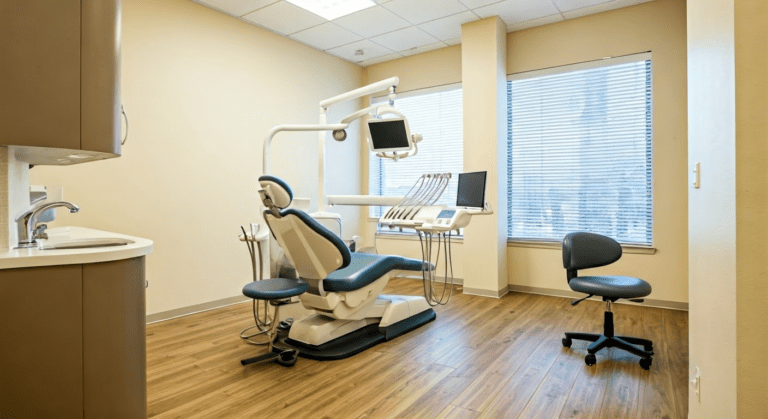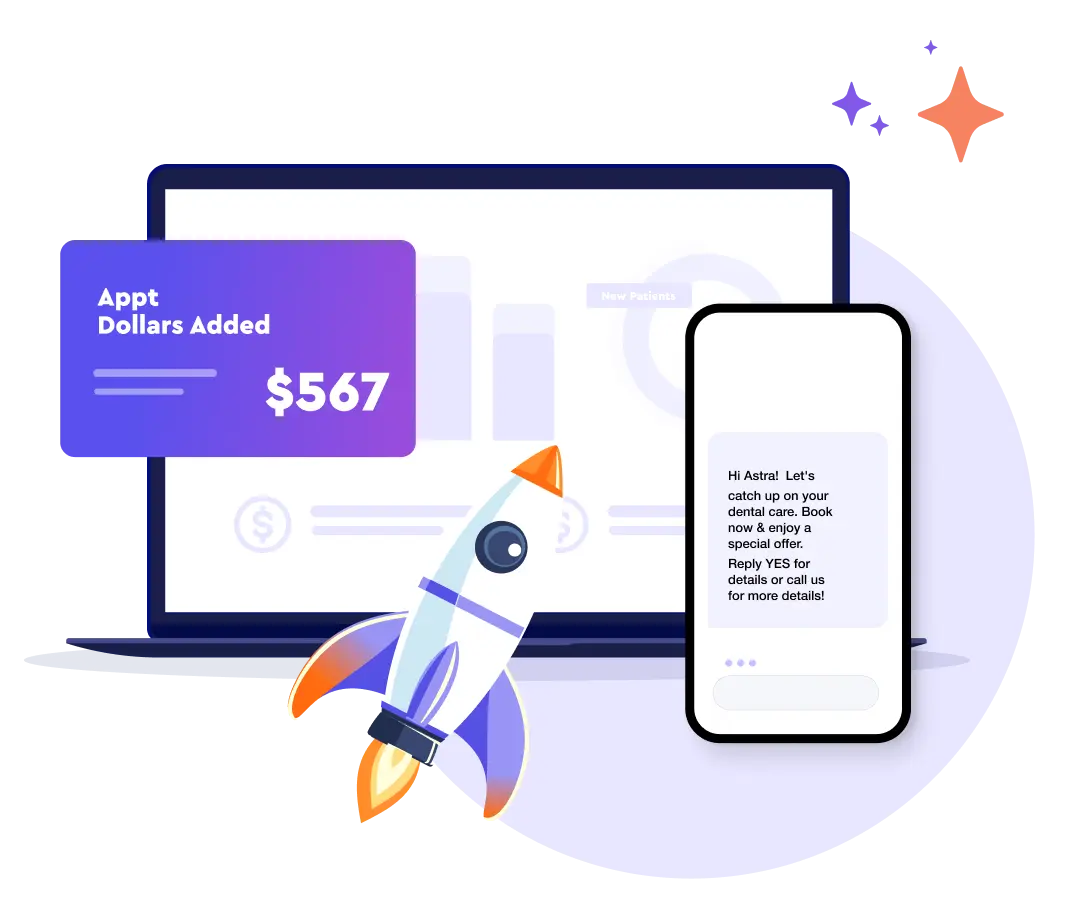10 Tricks to Improve Your Dental Scheduling ROI By 2X
If you’re a dental care provider, you’ve probably thought about automating your appointment scheduling.
It sounds simple— patients book online, reminders go out, and the calendar fills up.
But when you start exploring options, you quickly realize that dental scheduling isn’t the same as general medical scheduling.
Unlike other healthcare specialties,
dentistry requires precise time allocations for different procedures,
coordination between hygienists and dentists,
and strategic appointment placement to avoid bottlenecks.
A poorly managed schedule can lead to long patient wait times, provider burnout, and lost revenue due to no-shows.
But the difference between a chaotic schedule and a streamlined, high-performing one isn’t as big as you’d think. It comes down to a few key practices—ones that may seem obvious but are surprisingly easy to overlook.
So, we’re breaking down 10 must-do optimization tips to help you take control of your dental scheduling and make it work smarter for your practice.
What are the 10 Ways to Maximize AI in Dental Scheduling?
ChatGPT isn’t the only AI that can transform the way businesses operate.
We’ve come a long way from simple chatbots and automation scripts—today, AI can analyze vast amounts of patient data, predict no-shows, optimize scheduling, and even handle real-time patient communication.
But that’s just the beginning.
The real power of AI in dental scheduling comes when practices go beyond just using it and start maximizing its potential.
AI alone won’t solve every scheduling inefficiency—you need to stay a few steps ahead, fine-tuning your workflows to work with automation, not just around it.
Here’s how you can do that.
1. Use AI That Goes Beyond Just Scheduling
Traditional scheduling often operates on a first-come, first-served basis without considering patient needs, provider availability, or historical data. This results in inefficient appointment distribution and overbooked or underutilized slots.
How It Works:
- AI analyzes patient history, appointment urgency, and provider availability to suggest the best time slots.
- Real-time adjustments balance workload across the practice.
- Smart scheduling prioritizes high-value cases while keeping gaps to a minimum.
Example: Instead of a receptionist manually slotting in appointments, AI can predict the optimal schedule to reduce provider downtime and prevent back-to-back complex procedures that lead to fatigue.
2. Automate Patient Reminders & Confirmations
No-shows cost practices thousands of dollars annually. AI-powered patient engagement ensures timely email reminders and other notifications without requiring staff intervention.
How It Works:
- AI sends automated reminders via text, email, or phone based on patient preferences.
- Smart reminders adjust timing based on past patient response patterns.
- Two-way messaging enables patients to confirm, reschedule, or cancel instantly.
What This Means for Revenue: Reducing no-shows by even 5% can recover thousands in lost revenue while keeping the schedule consistently full.
3. Implement Predictive No-Show Prevention
Some patients are more likely to miss appointments than others. AI can flag high-risk no-shows before they happen and take preventive action.
How It Works:
- AI analyzes past behavior, appointment times, and demographics to predict no-show risks.
- Automated outreach provides extra reminders or alternative scheduling options.
- AI suggests overbooking strategies for high-risk time slots.
Example: If a patient has a history of missing afternoon appointments, the system can prioritize morning slots for them or send an additional reminder the day before.
4. Implement 24/7 Online Booking
Patients expect convenience. If they can book a flight or a hotel room online, they expect the same from their dentist without needing to make phone calls.
How It Works:
- AI-driven online booking allows patients to schedule, reschedule, or cancel anytime.
- Smart scheduling logic ensures only available and appropriate slots are offered.
- Integration with practice management software prevents double-booking.
5. Optimize Time Slot Allocation with Data-Driven Scheduling
Are your time slots optimized for actual procedure duration? Many practices follow outdated time blocks, leading to inefficiencies.
How It Works:
- AI analyzes appointment history to determine ideal time allocations.
- Scheduling adjusts dynamically based on provider speed and patient flow.
- AI minimizes gaps between appointments to increase daily capacity.
Example: A 30-minute time block for a cleaning might be too long for some hygienists but too short for others. AI adjusts based on real performance data.
6. Automate Call Handling & Scheduling
Even with online booking, many patients still call in. AI can handle these calls efficiently without overloading staff.
How It Works:
- AI-powered call analysis transcribes and categorizes patient inquiries in real time.
- Automated scheduling suggestions are provided based on the patient’s request.
- Sentiment analysis helps prioritize urgent or frustrated callers.
Impact: This ensures faster call handling, fewer missed appointments, and reduced front desk workload.
7. Implement an ASAP List for Cancellations
Last-minute cancellations don’t have to mean lost revenue. AI-driven waitlist management fills open slots quickly.
How It Works:
- AI automatically contacts patients on a waitlist when a slot opens.
- Smart matching prioritizes patients who need sooner appointments.
- Instant confirmation via text or email fills slots in real-time.
Example: If a patient cancels an 11 AM appointment, the system can instantly offer it to someone waiting rather than leaving it empty.
8. Offer Virtual Consultations for Pre-Screening
Not every visit requires an in-person appointment. Teledentistry can optimize scheduling by handling some cases remotely.
How It Works:
- Virtual consultations manage post-op checks, treatment plan discussions, and initial consultations.
- AI determines which cases can be handled online vs. in-office.
- Online scheduling ensures virtual visits don’t interfere with in-person workflow.
Revenue Impact: A practice that moves just 10% of its visits online can free up dozens of in-office slots for higher-value procedures.
9. Use Multilingual AI Assistance for Scheduling
Language barriers can lead to scheduling errors and no-shows. AI-powered translation tools ensure smooth communication.
How It Works:
- AI translates real-time booking inquiries into multiple languages.
- Automated reminders are sent in the patient’s preferred language.
- Speech-to-text translation assists staff in communicating with non-English-speaking patients.
Example: A Spanish-speaking patient can receive appointment details and reminders in their native language, reducing confusion and increasing attendance rates.
10. Track & Optimize Scheduling Performance with AI Analytics
Even with automation in place, continuous improvement is key. AI-powered analytics provide real-time insights to refine scheduling.
How It Works:
- AI tracks key scheduling metrics like no-show rates, peak hours, and provider utilization.
- Data-driven reports highlight inefficiencies and suggest improvements.
- Predictive analytics forecast future demand to help plan accordingly.
How to Find All the Features in One Place?
AI-powered scheduling sounds great—until you realize that most tools only solve one part of the problem.
You still need one tool for online booking, another for appointment reminders, another for patient analytics, another for call transcriptions, and yet another for translations. And if you want to automate patient reviews or track lost revenue from no-shows? That’s even more software to manage.
The result?
A messy, disconnected tech stack that creates more work instead of reducing it.
The real power of AI isn’t just automation—it’s integration. A truly optimized scheduling system should bring everything together: predictive scheduling, no-show prevention, patient engagement, workflow automation, review collection, analytics, call transcription, and even multilingual support—all working in sync.
That’s where Practice by Numbers (PbN) makes the difference.

Instead of patching together different tools, PbN offers an all-in-one AI-powered platform that doesn’t just handle scheduling—it optimizes every patient interaction.
From automatically filling last-minute cancellations to analyzing patient behavior and streamlining communication, PbN turns AI into a real operational advantage, not just another tech headache.
Real-World Example: How StoneRidge Dental Outdid Their Previous Metrics with Practice by Numbers

AI and automation in dental scheduling sound great in theory—but what about real results?
Let’s take a look at how StoneRidge Dental, a leading practice in Gilbert, AZ, transformed its operations, cut down inefficiencies, and maximized revenue with an all-in-one solution.
The Challenge: Too Many Tools, Not Enough Integration
Like many dental practices, StoneRidge Dental struggled with a disconnected tech stack. They had separate tools for scheduling, patient communication, analytics, and online payments—none of which worked seamlessly together.
The result?
Extra manual work for staff, inefficiencies in scheduling, and a lack of real-time insights into their practice’s performance.
The Solution: A Fully Integrated System with PbN
Dr. Nathan Saydyk, the owner of StoneRidge Dental, realized they needed a system that could do more than just one or two tasks—it needed to consolidate everything.
After exploring multiple platforms, he found that Practice by Numbers’ Grow bundle checked his every box.
By switching to PbN, StoneRidge Dental observed the following upper hand:



The Results: Higher Efficiency, More Revenue
Since implementing Practice by Numbers, StoneRidge Dental has seen significant improvements:
- $17,000 collected through PbN’s online payment system.
- 11% increase in hygiene pre-appointment rates.
- 17% increase in new patient pre-appointment rates.
Dr. Saydyk summed it up best:
“It does it all. It just does absolutely everything in one program. And you don’t find a lot of programs that do everything well. Yours does.”
Want to see similar results for your practice? Schedule a demo today to discover what PbN can do for you.
Conclusion
Optimizing dental scheduling goes far beyond simply booking appointments—it’s about aligning efficiency, patient satisfaction, and revenue growth under one seamless system.
What you need to focus on isn’t just adopting AI but maximizing its potential by integrating automation across every touchpoint of the scheduling process.
The difference between a practice weighed down by disconnected tools and one thriving with streamlined workflows often comes down to a single decision: choosing the right platform.
With a comprehensive AI-powered system, dental practices can turn scheduling from a constant headache into a strategic advantage—saving time, reducing errors, and unlocking new opportunities for growth.




